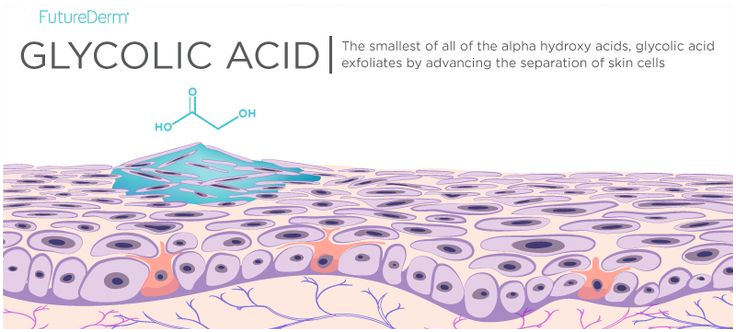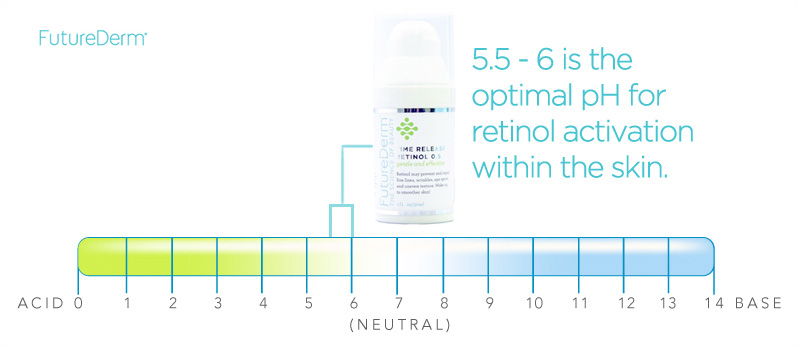
[easyazon_link identifier=”B00L1RGQM2″ locale=”US” tag=”cosmeticswiki-20″]Kate Somerville RetAsphere Micro Peel[/easyazon_link] is an innovative, leave-on micro peel designed to transform skin overnight while you sleep. It is formulated with a microencapsulated retinol system, called the RetAsphere Smart Release Carrier System, and 10 percent glycolic acid. Together these help to resurface skin to a smooth, soft texture, beginning after just one use. Though I normally do not like products with both retinol and acids — retinol requires a slightly higher pH to be activated within the skin, and glycolic acid can often take the skin out of this crucial pH range — the microencapsulated retinol in [easyazon_link identifier=”B00L1RGQM2″ locale=”US” tag=”cosmeticswiki-20″]Kate Somerville RetAsphere Micro Peel[/easyazon_link] means the retinol is being activated for up to 8 hours within the skin, long after the acidity of the glycolic acid has been neutralized. So both ingredients can work! For more, read on.
What Does Retinol Do?
Along with sunscreen, retinoids are still the gold standard of anti-aging in skin care. As Dr. Ranella Hirsch, M.D., the former president-elect of the American Society of Dermatologic Surgeons once said, “We have beautiful, profound data that shows if you use [retinoids] for 20 years, you’re going to look a lot better than someone who doesn’t.” Amen to that!
Retinoids like tretinoin are the only compounds to ever receive FDA approval for anti-aging and anti-sun damage. According to research by Fisher et. al, retinoids are effective in preventing and treating the collagen loss caused by photodamage. Anytime you go out into the sun, the UV exposure causes damage for a full day to two types of collagen in your skin, collagen types I and III. However, studies have shown treatment of the skin with retinoids may prevent the loss of these types of collagen.
In addition, Fisher et. al further demonstrated that application of retinoids inhibits collagen-degrading enzymes called matrix metalloproteinases from being activated within your skin, which may help to prevent further collagen loss.
What is the Difference Between Retinol and Prescription Retinoids?
There are a few differences.
First, the drug forms of vitamin A are already activated within your skin. On the other hand, over-the-counter retinol has to be changed within the skin to the active “drug” form. The reason you notice results from over-the-counter retinol is because there are a lot of enzymes naturally found in the uppermost layers of the skin that automatically convert retinol to its active form, tretinoin.
Secondly, over-the-counter retinol also penetrates the skin more deeply than prescription retinoids. When retinol is applied to skin samples, retinol is activated in all five skin layers, including the deepest layer (the dermis) (Toxicology and Skin Health, 2006). On the other hand, when you apply prescription tretinoin directly to the skin, it has been shown to work mainly on the uppermost layers of the skin. It all has to do with the chemical structure of the molecules — smaller, nonpolar molecules like retinol tend to traverse the skin better than large, more polar molecules like tretinoin. This means retinol traverses your skin and gets into the deepest layers, where collagen is formed. This helps to explain why people get similar results from over-the-counter retinol and prescription tretinoin: The over-the-counter retinol version needs to be activated in the skin, yes, but this is counteracted by the fact that over-the-counter retinol penetrates more deeply into the skin than prescription tretinoin.
What Does Glycolic Acid Do?
Glycolic acid acts as both a moisturizer and an exfoliator; it increases the skin’s supply of hyaluronic acid, which can hold 1000 times its weight in water. It also exfoliates by accelerating the rate of separation of skin cells (Skin Therapy Letter).
Glycolic acid is the smallest of the alpha hydroxy acids (AHAs), so it penetrates the skin more deeply than other AHAs like lactic acid and malic acid. Both in vitro and in vivo tests have shown glycolic acid use may increase collagen production, fibroblast proliferation, and cell turnover rates over time (Dermatologic Surgery).
A product like [easyazon_link identifier=”B00L1RGQM2″ locale=”US” tag=”cosmeticswiki-20″]Kate Somerville RetAsphere Micro Peel[/easyazon_link] has 10% glycolic acid, which is typical for at-home formulations, which usually range from 2 to 20 percent. At these concentrations, you should notice changes in fine lines, wrinkles, skin roughness, sun spots, and mild skin scarring. However, it usually takes dermatologist-grade glycolic acid treatments of 30 to 70 percent to notice differences in very deep wrinkles and scarring (Baumann).
Why I Am OK with Combining Microencapsulated Retinol and Glycolic Acid in[easyazon_link identifier=”B00L1RGQM2″ locale=”US” tag=”cosmeticswiki-20″]Kate Somerville RetAsphere Micro Peel[/easyazon_link], but Not Most Other Products
As renowned dermatologist Dr. Leslie Baumann, M.D., once told me in an interview, “You have to also be careful not to use a product that has ingredients that can render the active ingredient useless. Acids like glycolic acid can break down retinol and retinoids.”
Retinoids and acids simply function better when applied separately. This is because of a two-part process in which retinol is converted within your skin to become active: First enzymes in your skin convert retinol to retinaldehyde, then enzymes deeper within the skin convert retinaldehyde to the active form, all-trans retinoic acid.
Retinol conversion is simply optimized at a neutral pH, because the enzymes responsible for this oxidation, called retinol and retinal dehydrogenases (DHs), are most active at this pH range (Nature). So, in general, I do not recommend mixing retinoids and acids.
The Retasphere Smart Release™ Carrier System in the [easyazon_link identifier=”B00L1RGQM2″ locale=”US” tag=”cosmeticswiki-20″]Kate Somerville RetAsphere Micro Peel[/easyazon_link] changes the equation a bit. As the “capsule” dissolves slowly in your skin over the course of eight hours (using my best estimate on time), you’re getting a nice, slow, sustained delivery of retinol into your skin. Meanwhile, the surge of glycolic acid when you first apply the product initially makes your skin too acidic to convert retinol into its active form, but just for the first hour or so. After that first hour, your skin is back to a low-neutral pH range — and the skin should be able to convert the retinol that is being slowly released into the skin into its active form at that point. Bingo!
Which is a beautiful thing, because for about an hour you are getting the ability of glycolic acid to refine, exfoliate, brighten, and prep the skin for further products. And then, for about seven hours, you are benefitting from the action of retinol, improving the look of fine lines and wrinkles, firming the skin, and protecting collagen.
How Long Should You Use This Product?
I really like [easyazon_link identifier=”B00L1RGQM2″ locale=”US” tag=”cosmeticswiki-20″]Kate Somerville RetAsphere Micro Peel[/easyazon_link] and plan to use it weekly on an ongoing basis.
If you’re a true skin care product junkie and want to cruise to other products, there is research that shows retinol use benefits your skin for about two months after you stop using them (Acta Dermatologica, 1995). But after that, your skin will return to its normal state.
Personal Use and Opinions
[easyazon_link identifier=”B00L1RGQM2″ locale=”US” tag=”cosmeticswiki-20″]Kate Somerville RetAsphere Micro Peel[/easyazon_link] is a lightweight, clear, non-sticky formulation. It spreads evenly on the skin, and a little goes a surprisingly long way. It absorbs into the skin without a sticky or tacky feel. I did not feel any stinging or burning.
I put [easyazon_link identifier=”B00L1RGQM2″ locale=”US” tag=”cosmeticswiki-20″]Kate Somerville RetAsphere Micro Peel[/easyazon_link] on before I went to sleep one night. In the morning, I thought my skin felt softer and smoother.
I don’t have fine lines, wrinkles, or skin sagging, but after three weeks of once-weekly use, I do think that my skin looks more even-toned and my sunspots appear lighter.
Bottom Line
If you’re looking for an amazing product to give your skin care regimen a boost, I highly recommend [easyazon_link identifier=”B00L1RGQM2″ locale=”US” tag=”cosmeticswiki-20″]Kate Somerville RetAsphere Micro Peel[/easyazon_link]. It has an incredible microencapsulated form of retinol that allows you to benefit from both retinol and glycolic acid for up to seven hours — something unprecedented in the skin care market today. I truly love this product, and I highly recommend it to all of my readers.
Product Rating: 10/10. (High concentration of scientifically-proven ingredients: 3/3. Unique formulation or new technology: 3/3. Value: 3/3. Personal Results: 1/1).
Ingredients: Water, Glycolic Acid, Lactose, Isopulegol, Caprylic/Capric Triglyceride, Cetearyl Alcohol, Sodium Hydroxide, Neopentyl Glycol Diheptanoate, Propanediol, Glycerin, Glyceryl Stearate, Arbutin, Hydroxyethyl Acrylate/Sodium Acryloyldimethyl Taurate Copolymer, PEG-40 Stearate, Ethylhexyl Methoxycrylene, Trimethylpentanediol/Adipic Acid Copolymer, Polymethylsilsesquioxane, Phenoxyethanol, Glycine Soja (Soybean) Extract, Polysorbate 20, Opuntia Ficus-Indica Fruit Extract, Magnesium Aluminum Silicate, Xanthan Gum, Retinol, Ceteareth-20, Dimethicone, Fragrance/Parfum, Cetyl Palmitate, Laureth-23, Saccharomyces Cerevisiae Extract, Hydrolyzed Hyaluronic Acid, Tocopheryl Acetate, Ethylhexylglycerin, Disodium EDTA, Adenosine, Ceramide NP, Trideceth-6 Phosphate, Triethanolamine, Glycyrrhiza Glabra (Licorice) Root Extract, Plankton Extract.








